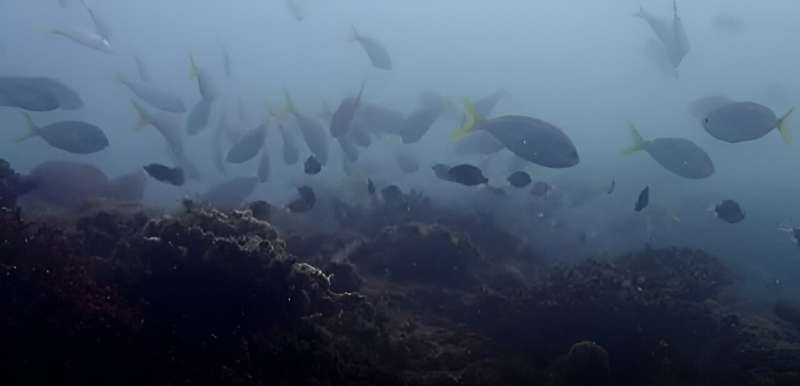This article has been reviewed according to Science X's editorial process and policies. Editors have highlighted the following attributes while ensuring the content's credibility:
fact-checked
trusted source
proofread
Snapping shrimp create rowdy reef in Kimberley Marine Park

Underwater reefs are generally thought of as tranquil places—however some truly unruly residents make one such area off the coast of northwestern Australia anything but quiet.
Marine experts from Curtin University and the Western Australian Museum were diving in the West Holothuria Reef complex in Wunambal Gaambera wundaagu saltwater country off the Kimberley coast of WA, when they encountered snapping shrimp making a loud noise similar to frying bacon.
As part of the Kimberley Reef Connect project, Trip Leader Associate Professor Zoe Richards from Curtin University's School of Molecular and Life Sciences was recording coral biodiversity when she noticed the sounds.
"Healthy reefs can be quite noisy but on this particular reef, the clicking and crackling sounds were so loud I had to take a moment to stop recording the corals and just listen in awe," she said.
"I have never dived on such a naturally rowdy reef—it was something I will never forget."
Snapping shrimp have a specialized, oversized claw which snaps shut to create a shockwave to stun passing prey so it can be captured.
They also use their claws for communicating, digging burrows, fighting rival shrimp for territory and warding off would-be predators.
They are found throughout Australia, with 150 species capable of making the characteristic snapping sound.
Associate Professor Richards said she believed this may be one of the noisiest reefs in Australia, though a dedicated trip to study the shrimp's chorus' noise levels would be needed to know for sure.
Western Australian Museum Curator of Crustacea Dr. Andrew Hosie said there would have been multiple species in abundance at the site to make such a cacophony.
"The underwater 'shrimphony' of noise created by populations of snapping shrimp can even be loud enough to create interference with underwater acoustic communications," he said.
"The snaps of some species have been recorded at over 200 decibels, which is as loud as whale song."
The Kimberley Reef Connect project was undertaken in collaboration with the Western Australian Museum, Wunambal Gaambera Aboriginal Corporation and Uunguu Rangers.
Federal Minister for the Environment and Water Tanya Plibersek said the Kimberley Reef Connect project is revealing the exceptional biodiversity and cultural value of Australian Marine Parks.
"The Kimberley Marine Park covers an area bigger than Tasmania and features a vast area of deep, unexplored underwater habitat," Minister Plibersek said.
"Marine discovery and survey expeditions increase our understanding of the weird and wonderful sea creatures that inhabit ocean reefs—such as snapping shrimp—so we can ensure they are protected for our kids and grandkids."
Provided by Curtin University




















